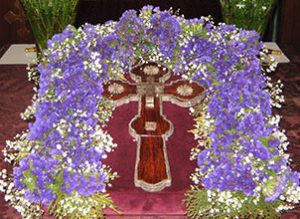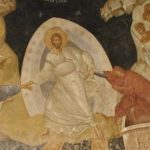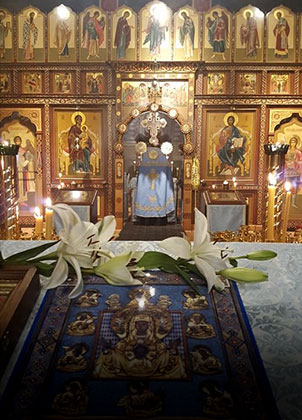Столетний юбилей Указа Патриарха Тихона
В этом году мы отмечаем столетний юбилей основания РПЦЗ (19 ноября 1920 г.), но важно отметить и другой, не менее значимый юбилей – сто лет со дня опубликования «Постановления Святейшего Патриарха, Священного Синода и Высшего Церковного Совета Православной Российской Церкви от 7/20 ноября 1920 года за № 362» или, как он обычно называется для краткости, Указ патр. Тихона №362.
Многократно отмечались мудрость и промыслительное значение этого Указа для Русской Церкви. Достаточно сказать, что спустя сто лет после его издания, он остается каноническим основанием и руководящим принципом для всех епископов российского истинного православия. За последнее столетие не раз изменялась раскладка политических сил в мире, но Указ св. Патриарха продолжает направлять нас в каноническом церковном русле в наше пред-антихристово время.
Прежней РПЦЗ уже не существует, от нее остались «осколки», разрозненные, часто даже враждующие группы. Замечательно, что во всех этих церковных образованиях хранится убеждение, что Указ №362 дает им канонический фундамент. Таким образом, Указ патр. Тихона может стать объединительным краеугольным камнем, на котором будет построено наше духовное единство.
Все почитают Указ №362 своим каноническим основанием, но подчас приписывают ему значение, прямо противоположное его истинному намерению. Хотя, при беспристрастном подходе, смысл Указа вполне ясен. Он был составлен в ожидании того, что большевики уничтожат или изолируют Высшее Церковное Управление Русской Церкви. В таком случае, Русская Церковь оказалось бы раздробленной на отдельные епархии, и Церковь лишилась бы канонической соборности.
Что же предписывает Указ в таких обстоятельствах, когда более не существует законной Высшей Церковной власти? Епископы должны организоваться в самоуправляющиеся Церковные Округа, состоящие из нескольких епархий, по территориальному принципу.
Здесь нужно обратить внимание на два аспекта: Указ Патриарха, с одной стороны, не дозволяет епископам оставаться в одиночестве и действовать самостоятельно, но с другой стороны, не предписывает создание какого-либо альтернативного обще-церковного центра вместо Высшего Церковного Управления, уничтоженного большевиками. Таким образом, Указ избирает средний путь между централизацией церковного управления и, наоборот, полной атомизацией Церкви.
Однако, Патриарший Указ, отменяя строгую централизацию и предоставляя Церковным Округам права самоуправления, предполагает, что они будут объединены духовным единством.
Нужно еще отметить несколько важных пунктов, вытекающих из Указа №362:
Церковные Округа, предписываемые Указом, являются временными админстративными единицами, действующими только до тех пор, пока не станет возможным восстановление законного Высшего Церковного Управления. Юрисдикция этих Церковных Округов распространяется только на тех, кто на добровольных началах присоединился к ним. Церковные Округа сохраняют административную независимость и не подчинены один другому, но при этом находятся в евхаристическом общении и в совокупности составляют единую Российскую Церковь. Ни один из этих Округов не имеет права претендовать на власть над другими Округами или над всей полнотой Русской Церкви. Такие претензии были бы незаконной узурпацией власти в Церкви.
К сожалению, Предстоятели ныне существующих ветвей РПЦЗ не хотят в точности исполнять Патриарший Указ № 362, самочинно приписывая себе полномочия Высшей Церковной власти, что и является одной из причин их маргинализации и уклонения в сектантский дух.
Путь к примирению различных групп русского истинного православия откроется только в том случае, если мы признаем возможным существование нескольких параллельных самоуправляющихся юрисдикций, как это и предвидит Патриарший Указ.
Следуя в точности духу и букве Указа св. Патр. Тихона, станет возможным объединение различных ветвей РПЦЗ, на основе духовного, евхаристического единства и соборности Церкви как мистического Тела Христова, а не единства внешнего, административного, как земной организации.
Еп. Андрей
Использовались материалы вебсайта «Церковная Жизнь».
One hundredth year Jubilee of Patriarch Tikhon’s Ukase (Decree)
This year, we are celebrating the hundredth year jubilee of the establishment of ROCA (19th November 1920), but it’s important that we also commemorate a jubilee no less significant – one hundred years from the day of publication of the “Decree of the Holy Patriarch, the Holy Synod and the Supreme Ecclesiastical Council of the Russian Orthodox Church from 7/20 November 1920, No. 362”, or, as it is usually called for brevity, Patriarch Tikhon’s Ukase No. 362.
The wisdom and providential meaning of this Ukase to the Russian Church has been noted many times. Sufficient to say that with the passing of one hundred years after its publication, it remains the canonical foundation and the governing principle for all the Bishops of the Russian True Orthodoxy. Over the past hundred years, the arrangement of political powers in the world has changed more than once, but Holy Patriarch’s Ukase continues to direct us in the canonical church course in our pre-antichrist time.
The former ROCA doesn’t exist anymore; only Her “fragments” remain, separated and often hostile to one another. It’s remarkable that in all these church formations there resides a conviction that Ukase No. 362 gives them a canonical foundation. Thus, Patriarch Tikhon’s Ukase may become the uniting cornerstone upon which our spiritual unity may be erected.
Everybody respects Ukase No. 362 as their canonical basis, but quite often they ascribe a meaning to it that is directly converse to its true intent, even though an impartial approach makes the meaning of the Ukase quite clear. It was drafted in the expectation that the Bolsheviks will destroy or isolate the Supreme Church Authority of the Russian Church, in which case the Russian Church would find Herself fragmented into separate dioceses, and the Church would lose Her canonical conciliarity.
So what does the Ukase prescribe in these situations, when essentially the Supreme Church Authority is non-existent? The Bishops must organise themselves in autonomous Church Districts, made up of several dioceses, on a territorial basis.
Here, we need to pay attention to two aspects: on the one hand, the Patriarch’s Ukase doesn’t allow the Bishops to remain in isolation and act independently, while on the other hand, it doesn‘t prescribe the formation of some type of alternative general Church centre instead of the Supreme Church Authority, which had been destroyed by the Bolsheviks. This way, the Ukase chooses the middle path between the centralisation of Church Authority, and conversely, a full atomisation of the Church.
At the same time, in annulling the strict centralisation and presenting the Church Districts the right of autonomy, the Patriarchal Ukase presumes that they will be joined in spiritual unity.
It’s also necessary to note a few important key points that flow from the Ukase No.362:
Church Districts prescribed by the Ukase, appear as temporary administrative units, functioning only up to that time when it becomes possible to re-establish the lawful Supreme Church Authority. The jurisdiction of these Church Districts extends only to those who have joined them on a voluntary basis. The Church Districts retain their administrative autonomy and are not subordinate to one another, but at the same time, are in a Eucharistic communion and together comprise the one Russian Church. Not one of these Districts has the pretension of authority over other Districts, or over the entire Russian Church. Such pretensions would be unlawful usurpation of power in the Church.
Unfortunately, the Primates of the existing branches of ROCA don’t want to fulfil with exactness the Patriarchal Ukase No. 362, unilaterally ascribing themselves the powers of the Supreme Church Authority, which is one of the reasons for their marginalisation and divergence into the sectarian spirit.
The path toward reconciliation of the various groups of the Russian True Orthodoxy will emerge only if we acknowledge the possibility of the existence of several parallel autonomous jurisdictions, just as envisaged by the Patriarchal Ukase.
Only by following precisely in letter and spirit of Holy Patriarch’s Ukase, will it become possible to unite all the ROCA branches, on the basis of a spiritual, Eucharistic unity and conciliarity of the Church as a mystical Body of Christ, and not an outer administrative unity akin to an earthly organisation.
Bishop Andrei.
Material from website “Church Life” has been utilised.









